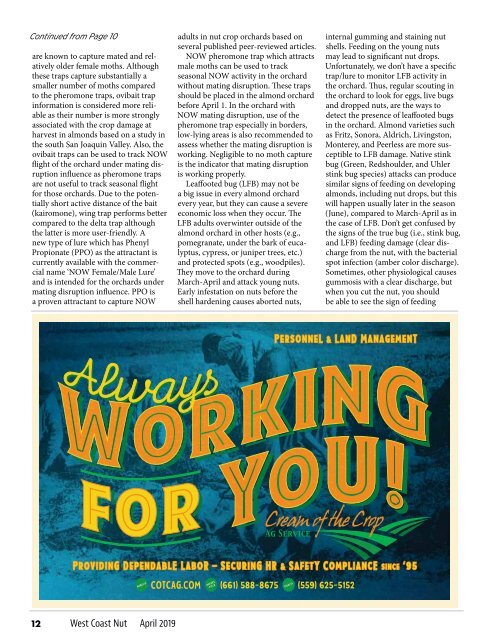WCN April 2019
Create successful ePaper yourself
Turn your PDF publications into a flip-book with our unique Google optimized e-Paper software.
Continued from Page 10<br />
are known to capture mated and relatively<br />
older female moths. Although<br />
these traps capture substantially a<br />
smaller number of moths compared<br />
to the pheromone traps, ovibait trap<br />
information is considered more reliable<br />
as their number is more strongly<br />
associated with the crop damage at<br />
harvest in almonds based on a study in<br />
the south San Joaquin Valley. Also, the<br />
ovibait traps can be used to track NOW<br />
flight of the orchard under mating disruption<br />
influence as pheromone traps<br />
are not useful to track seasonal flight<br />
for those orchards. Due to the potentially<br />
short active distance of the bait<br />
(kairomone), wing trap performs better<br />
compared to the delta trap although<br />
the latter is more user-friendly. A<br />
new type of lure which has Phenyl<br />
Propionate (PPO) as the attractant is<br />
currently available with the commercial<br />
name ‘NOW Female/Male Lure’<br />
and is intended for the orchards under<br />
mating disruption influence. PPO is<br />
a proven attractant to capture NOW<br />
adults in nut crop orchards based on<br />
several published peer-reviewed articles.<br />
NOW pheromone trap which attracts<br />
male moths can be used to track<br />
seasonal NOW activity in the orchard<br />
without mating disruption. These traps<br />
should be placed in the almond orchard<br />
before <strong>April</strong> 1. In the orchard with<br />
NOW mating disruption, use of the<br />
pheromone trap especially in borders,<br />
low-lying areas is also recommended to<br />
assess whether the mating disruption is<br />
working. Negligible to no moth capture<br />
is the indicator that mating disruption<br />
is working properly.<br />
Leaffooted bug (LFB) may not be<br />
a big issue in every almond orchard<br />
every year, but they can cause a severe<br />
economic loss when they occur. The<br />
LFB adults overwinter outside of the<br />
almond orchard in other hosts (e.g.,<br />
pomegranate, under the bark of eucalyptus,<br />
cypress, or juniper trees, etc.)<br />
and protected spots (e.g., woodpiles).<br />
They move to the orchard during<br />
March-<strong>April</strong> and attack young nuts.<br />
Early infestation on nuts before the<br />
shell hardening causes aborted nuts,<br />
internal gumming and staining nut<br />
shells. Feeding on the young nuts<br />
may lead to significant nut drops.<br />
Unfortunately, we don’t have a specific<br />
trap/lure to monitor LFB activity in<br />
the orchard. Thus, regular scouting in<br />
the orchard to look for eggs, live bugs<br />
and dropped nuts, are the ways to<br />
detect the presence of leaffooted bugs<br />
in the orchard. Almond varieties such<br />
as Fritz, Sonora, Aldrich, Livingston,<br />
Monterey, and Peerless are more susceptible<br />
to LFB damage. Native stink<br />
bug (Green, Redshoulder, and Uhler<br />
stink bug species) attacks can produce<br />
similar signs of feeding on developing<br />
almonds, including nut drops, but this<br />
will happen usually later in the season<br />
(June), compared to March-<strong>April</strong> as in<br />
the case of LFB. Don’t get confused by<br />
the signs of the true bug (i.e., stink bug,<br />
and LFB) feeding damage (clear discharge<br />
from the nut, with the bacterial<br />
spot infection (amber color discharge).<br />
Sometimes, other physiological causes<br />
gummosis with a clear discharge, but<br />
when you cut the nut, you should<br />
be able to see the sign of feeding<br />
PersonneL & LanD ManagemenT<br />
ProvidinG DependablE LaboR — SecurinG HR & SafetY CompliancE since ‘95<br />
WEBSITE<br />
COTCAG.COM<br />
BAKERS<br />
-FIELD<br />
(661) 588-8675<br />
VISALIA<br />
(559) 625-5152<br />
12<br />
West Coast Nut <strong>April</strong> <strong>2019</strong>


















